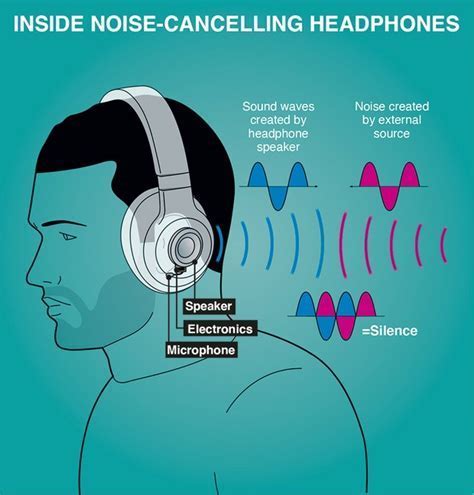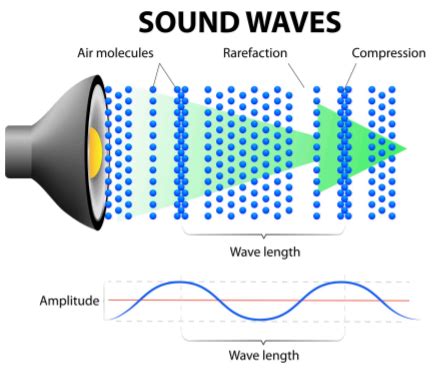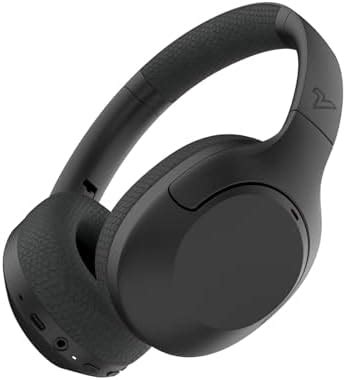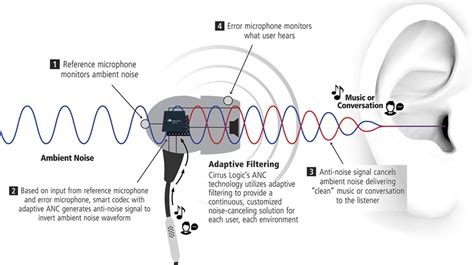Have you ever wondered how that pleasant silence is achieved in your headphones, effortlessly blocking out the noise around you? The answer lies in a remarkable feature known as Active Noise Cancellation (ANC). This advanced technology, implemented in modern headsets, enables you to immerse yourself in your favorite music or focus on your work without distractions.
ANC, also referred to as noise reduction or noise isolation, is a phenomenon that has revolutionized the audio industry. It works by employing an array of microphones, intelligent algorithms, and innovative circuitry to combat external sounds. By carefully monitoring the sound waves in your surroundings, ANC technology actively generates an "anti-noise" signal to counteract and neutralize the unwanted auditory interference.
Unprecedented comfort and a truly immersive audio experience are the result of this groundbreaking innovation. With ANC, you can enjoy your music or podcasts with exceptional clarity, even in bustling environments such as airports, busy streets, or crowded cafes. This remarkable technology brings the audio quality and peace to a whole new level, allowing you to escape from the outside world and immerse yourself fully in your audio content.
Understanding the Mechanism Behind Active Noise Cancelling in Headphones

In the realm of contemporary audio technology, headphones equipped with Active Noise Cancelling (ANC) have revolutionized the way we experience sound. By intelligently counteracting external auditory disturbances, ANC headphones transport us to an oasis of tranquility, allowing us to fully immerse ourselves in our desired audio experience. But what lies behind the magic of ANC headphones? How do they effortlessly attenuate the cacophony of the outside world and deliver a pristine audio escapade?
The Essence of ANC:
ANC headphones utilize an advanced electronic mechanism to eliminate unwanted noise and provide unparalleled audio clarity. The primary objective of ANC technology is to discern and neutralize external sounds by producing anti-noise signals that cancel out the unwanted sound waves. Through this ingenious process, ANC headphones create a silent bubble within which every auditory nuance can be fully appreciated.
Unraveling the Science:
At the core of ANC lies the concept of destructive interference–an acoustic phenomenon in which sound waves of precisely opposite phases collide, resulting in their mutual cancellation. ANC headphones capitalize on this principle by employing microphones to capture external noises in real-time. These captured sounds are meticulously analyzed to ascertain their frequency and amplitude characteristics. The ANC circuitry then generates anti-noise signals, which are produced in precise phase and amplitude to effectively neutralize the incoming noise.
Emergence of Silence:
Once the anti-noise signals are generated, they are seamlessly combined with the original audio signal to create an immersive audio experience devoid of external disturbances. ANC headphones achieve this by introducing the generated anti-noise signal to the listening environment, effectively eradicating the superimposed noise. The result is a harmonious equilibrium of sound, allowing us to revel in the pure audio bliss and fully appreciate the depth and nuances of our desired audio content.
Unleashing the Potential:
ANC headphones have become an essential tool for individuals seeking solace in crowded environments, avid travelers craving uninterrupted audio moments, or professionals striving for focused work sessions. By harnessing cutting-edge technology and relying on the principles of sound interference, ANC headphones have become a gateway to a world where external interruptions are muffled, allowing individuals to fully immerse themselves in the soundscape of their choosing.
In conclusion, ANC headphones employ a fascinating fusion of technology and acoustics to create an environment where unwanted sounds are silenced, enabling us to savor the beauty of sound blissfully undisturbed. Through the clever manipulation of sound waves, ANC headphones have elevated audio experiences to new heights.
The Fundamentals of ANC Technology
Discovering the underlying principles of Active Noise Cancellation (ANC) unveils an innovative realm where limitations of external disturbances are triumphantly conquered. This section will delve into the core concepts that empower ANC technology, unraveling the secrets behind its remarkable ability to eradicate unwanted noise and immersing users in a cocoon of sonic harmony.
Understanding Sound Waves and Noise

The study of sound waves and noise is essential in comprehending the functioning of active noise cancellation (ANC) technology in headphones. By examining the characteristics of sound waves and the nature of noise, we can gain a deeper understanding of how ANC works to create a more immersive and tranquil listening experience.
1. Sound Waves
Sound waves are the result of vibrations that propagate through a medium, such as air or water. These vibrations create pressure variations that our ears perceive as sound. Understanding the properties of sound waves, such as frequency, wavelength, and amplitude, is crucial in comprehending the mechanisms behind ANC.
2. Noise
Noise refers to any unwanted or disruptive sound that interferes with our desired auditory experience. It can originate from various sources, including environmental factors, electrical disturbances, or even electronic devices. The ability to distinguish noise from desired audio signals is fundamental in ANC technology.
3. Active Noise Cancellation
Active noise cancellation is a technology that reduces unwanted noise by generating sound waves that are out of phase with the noise. By creating these antiphase sound waves, ANC headphones effectively cancel out the unwanted noise, providing a quieter listening environment. Understanding the principles of sound wave interference and cancellation is key to comprehending how ANC operates.
- 3.1 Phase and Interference
- 3.2 Microphones and Feedback
Phase refers to the position of a sound wave at a specific point in its cycle. The interference of sound waves occurs when two or more waves interact, resulting in constructive or destructive interference. ANC headphones exploit this principle to cancel out noise by generating antiphase sound waves that interfere destructively with the unwanted noise.
ANC headphones include built-in microphones that capture the ambient noise. These microphones send the noise signal to a processing unit, which analyzes the acoustic characteristics of the noise. By generating an appropriate antiphase sound wave, the ANC system provides a negative feedback mechanism, effectively suppressing the unwanted noise.
In conclusion, by having a solid understanding of sound waves, noise, and the technology behind ANC, we can appreciate how ANC headphones create a more immersive and peaceful audio experience by actively canceling out unwanted noise.
Understanding Active Noise Cancelling (ANC)
The concept of active noise cancelling, often abbreviated as ANC, involves the use of advanced technology in headphones to reduce or eliminate unwanted sounds from the surrounding environment. ANC technology intelligently analyzes the ambient noise and generates an opposite sound wave, often referred to as an anti-noise or counter-signal, which aims to cancel out the unwanted sounds effectively.
By employing ANC technology, headphones with this feature actively work to counteract external noise, creating a more immersive audio experience for the user. ANC not only allows for a clearer and more focused listening experience but also helps in reducing listener fatigue by minimizing the need to increase the volume to compensate for external noise.
A key component of ANC headphones is the use of built-in microphones. These microphones capture the external sounds and feed them into electronic circuitry within the headphones. This circuitry then analyzes the frequency and intensity of the ambient noise, allowing the ANC system to generate the appropriate counter-signals.
| Advantages of ANC in Headphones: | Disadvantages of ANC in Headphones: |
|---|---|
| - Enhanced audio quality | - Increased power consumption |
| - Reduced background noise | - Potential audio artifacts |
| - Improved concentration and focus | - Higher cost compared to regular headphones |
| - Increased comfort during long listening sessions | - Dependent on battery operation for ANC feature |
ANC technology has evolved significantly over the years, resulting in the availability of headphones with various levels of noise cancellation. From reducing constant low-frequency sounds such as engine noise during a flight to minimizing the chatter in a busy café, ANC-equipped headphones have become a popular choice for those seeking a more peaceful and immersive listening experience.
Explaining the Mechanism Behind Blocking Out External Noise

When it comes to mitigating the impact of surrounding sounds and noises, ANC technology plays a vital role. This advanced feature found in headphones enhances the listening experience by suppressing unwanted sounds, allowing users to enjoy their audio content without any distractions. Curious to know how exactly ANC works in blocking out external noise? Let's delve into the intricacies of this technology.
ANC technology operates on the principle of analyzing and countering incoming sounds. By utilizing built-in microphones, the headphones can identify ambient noises and generate corresponding sound waves to neutralize them. These generated waves are carefully crafted to have the opposite polarity of the external sounds, effectively canceling them out.
| Key Components of ANC Technology | Benefits |
|---|---|
| Microphones | Enable the detection of external sounds, allowing for accurate noise cancellation. |
| Processing Unit | Receives signals from the microphones, analyzes the frequency and amplitude of the ambient sounds, and generates corresponding anti-noise signals. |
| Anti-Noise Signals | Generated by the processing unit, these signals interact with the incoming sounds to cancel them out completely or significantly reduce their impact. |
| Speakers | Deliver high-quality audio content after the disruptive external sounds have been eliminated or attenuated. |
The effectiveness of ANC technology relies on the ability of the headphones to accurately detect and counter surrounding noises. By continuously monitoring the soundscape, ANC headphones can adapt and adjust the anti-noise signals in real-time to provide optimal noise cancellation.
Thanks to ANC technology, users can immerse themselves in their audio experience, whether it be music, movies, or conference calls, without being disturbed by the hustle and bustle of their surroundings. ANC-enabled headphones truly offer a sanctuary of tranquility and high-quality sound.
Inverting Sound Waves: The Principle
The fundamental concept behind active noise cancellation (ANC) in headphones revolves around inverting or reversing the sound waves present in the surrounding environment. By doing so, ANC headphones effectively neutralize or cancel out unwanted external noise, allowing the listener to enjoy a more immersive and peaceful audio experience.
ANC headphones achieve this by utilizing a combination of microphones, signal processing, and speakers. The microphones on the headphones pick up the ambient sound waves and convert them into electrical signals. These signals are then processed in real-time by the ANC circuitry, which generates an inverted replica of the original sound waves.
- The inverted sound waves are then fed into the headphone speakers simultaneously with the original sound waves from the audio source.
- As the original sound waves and the inverted sound waves combine, their peaks and troughs align and cancel each other out, resulting in a significant reduction in the perceived external noise.
This intricate process of inverting sound waves and superposing them with the original sound waves is repeated continuously to adapt to changes in the surrounding noise environment. ANC headphones are designed to target and counteract low-frequency sounds, such as airplane engines, traffic noise, and air conditioning hum, which are the most common sources of annoyance.
By effectively countering external noise, ANC headphones enhance the listening experience by bringing out more clarity and detail in the desired audio content. Whether it's immersing oneself in a music concert, focusing on work in a noisy environment, or simply seeking tranquility in a bustling city, ANC headphones offer a valuable solution to create a more peaceful and immersive auditory experience.
Microphones and Adaptive Noise Cancellation: How Headphones Adjust to Surroundings

In order to create an immersive and uninterrupted audio experience, modern headphones utilize a technology called active noise cancellation (ANC). This technology, powered by microphones embedded within the headphones, allows the device to adapt and dynamically respond to the surrounding environment.
Microphones: One of the crucial components for ANC in headphones is the presence of microphones. These small yet essential devices play a key role in capturing external sounds and analyzing the acoustic environment. By constantly monitoring the ambient noise, the microphones provide vital information to the ANC system, enabling it to make real-time adjustments.
Adaptive Noise Cancellation: Thanks to the data collected by the microphones, the ANC system can effectively cancel out unwanted sounds. By analyzing both the external noise and the audio signal being played, the headphones can generate equal and opposite sound waves. These waves, referred to as anti-noise or inverted sound waves, counteract the ambient noise, ultimately reducing its impact on the user's listening experience.
Surroundings: The ability of headphones to adapt to different surroundings is a remarkable feature of ANC. Whether in a bustling coffee shop, on a busy street, or during a flight, the microphones constantly monitor the environment to optimize the noise cancellation process. This ensures that users can enjoy their favorite music or podcasts without any interruptions or distractions from external noises.
Processing and Cancelling Out Noise: ANC Algorithms
In the realm of audio technology, the quest to deliver a pristine sound experience in headphones has led to the development of Active Noise Cancellation (ANC) algorithms. These advanced algorithms enable headphones to analyze and counterbalance ambient noise, thereby enhancing the audio quality for the user.
ANC algorithms incorporate intricate signal processing techniques to discern the unwanted noise from the desired audio signal. By leveraging various mathematical models and computations, these algorithms identify the specific characteristics of noise and generate corresponding anti-noise signals to nullify its effects.
The core principle behind ANC algorithms lies in their ability to sample the ambient noise and efficiently generate an anti-noise waveform. This waveform is then combined with the audio signal, effectively canceling out the unwanted noise components. It is essential for ANC algorithms to accurately measure the noise parameters in real time to adapt the anti-noise waveform consistently.
One key approach used in ANC algorithms is feedforward cancellation, which involves capturing the ambient noise using external microphones placed strategically on the headphones. These microphones pick up the incoming noise and transmit it to a digital signal processor (DSP) for analysis. The DSP then generates a corresponding anti-noise signal, which is mixed with the audio signal before reaching the user's ears.
In addition to feedforward cancellation, ANC algorithms also incorporate feedback cancellation techniques. By using internal microphones placed close to the user's ears, these algorithms capture the residual noise that escapes cancellation during the feedforward stage. This information is then utilized to further refine the anti-noise waveform and improve the overall noise cancellation performance.
ANC algorithms continuously monitor and adapt to environmental changes, ensuring effective noise cancellation across a wide range of scenarios. They employ advanced filtering and equalization techniques to accurately generate the anti-noise signal, effectively reducing the perception of ambient noise and delivering a more immersive listening experience.
In conclusion, ANC algorithms play a crucial role in the functionality of headphones by actively processing and canceling out ambient noise. Through a combination of feedforward and feedback cancellation techniques, these algorithms enable headphones to provide an enhanced audio experience by effectively reducing unwanted noise components.
Types of Noise Cancelling Systems in Headphones

When it comes to reducing unwanted ambient noise in headphones, there are various types of noise cancelling systems available. These systems employ different techniques and technologies to create an immersive listening experience, isolating the user from external distractions. In this section, we will explore some of the common types of noise cancelling systems found in headphones.
| Noise Cancelling Type | Description |
|---|---|
| Passive Noise Isolation | Passive noise isolation is the basic method used to reduce external noise. It involves the design of the headphones themselves, which use materials and padding to block out sound. While it can provide some level of noise reduction, it is not as effective as active noise cancelling systems. |
| Active Noise Cancellation (ANC) | Active noise cancellation is a popular technology used in modern headphones. It works by using built-in microphones to capture the ambient sound and then generate an opposite sound wave called anti-noise. These two sound waves cancel each other out, minimizing external noise and creating a more immersive audio experience. |
| Hybrid Noise Cancellation | Hybrid noise cancellation combines both passive noise isolation and active noise cancellation techniques. This approach aims to maximize noise reduction by utilizing the benefits of both methods. The passive isolation blocks out high-frequency sounds, while the active cancellation targets low-frequency sounds, resulting in an enhanced level of noise reduction. |
| Adaptive Noise Cancellation | Adaptive noise cancellation is a sophisticated system that dynamically adjusts the level of noise cancellation based on the surrounding environment. It utilizes advanced algorithms and sensors to continuously analyze the ambient noise and adapt the noise cancellation settings to optimize the listening experience. This type of ANC is ideal for those who frequently move between different environments. |
Each type of noise cancelling system has its own advantages and limitations. The choice of ANC technology depends on personal preferences and the specific use case. Whether you prefer a basic passive noise isolation or the advanced adaptive noise cancellation, there is a wide variety of headphones available catering to different needs and budgets.
Feedforward ANC vs Feedback ANC
When it comes to noise-canceling technology in headphones, there are two main approaches: feedforward ANC and feedback ANC. These two methods differ in the way they work and their effectiveness in reducing unwanted environmental sounds.
Feedforward ANC, also known as open-loop ANC, operates by capturing the ambient sound around the listener and generating an anti-noise signal to cancel out the unwanted noises. It does not rely heavily on internal microphones but instead uses external microphones placed on the outside of the headphones. This allows feedforward ANC to have a faster response time and perform well in attenuating sudden, impulsive noises.
On the other hand, feedback ANC, also known as closed-loop ANC, relies on internal microphones placed within the ear cups of the headphones to capture the sound that reaches the listener's ears. By analyzing this sound, the ANC system generates an anti-noise signal that is then played back through the headphone drivers to counteract the environmental noises. Feedback ANC is generally known for its effectiveness in reducing consistent, low-frequency noises.
Both feedforward and feedback ANC have their advantages and disadvantages. Feedforward ANC tends to be more effective in cancelling high-frequency noises, such as voices or car horns, due to its faster response time. However, it may struggle with low-frequency noises or noises that are in close proximity to the listener. Feedback ANC, while better at reducing low-frequency sounds, may introduce audio artifacts or a slight delay in sound due to its reliance on internal microphones.
In conclusion, the choice between feedforward ANC and feedback ANC depends on the specific use case and individual preferences. Some headphones may even implement a combination of both methods to provide a more comprehensive noise-canceling experience. Understanding the differences between these two approaches can help users make informed decisions when selecting headphones with ANC capabilities.
Hybrid ANC: Combining Feedforward and Feedback

One innovative approach to active noise cancellation (ANC) in headphones is the development of a hybrid system that combines both feedforward and feedback techniques. This unique combination allows for superior noise reduction and a more immersive audio experience.
A feedforward ANC system involves using microphones placed on the exterior of the headphones to capture incoming sound waves. These microphones detect ambient noise and then generate an opposing sound wave that cancels out the unwanted noise before it reaches the listener's ears. This method is highly effective at attenuating constant or predictable noise sources, such as airplane engines or air conditioning units.
On the other hand, feedback ANC relies on internal microphones within the headphones to capture sound directly inside the earcup. These microphones pick up any sound leakage or unwanted noise that may occur due to imperfect isolation. By analyzing and processing this internal sound, the ANC system creates an appropriate counter sound wave to effectively cancel out the residual noise perceived by the listener.
By combining both feedforward and feedback techniques, hybrid ANC systems can compensate for the limitations of each method. This hybrid approach offers several advantages, including improved attenuation of unpredictable noise sources, better isolation of high-frequency sounds, and increased overall ANC performance.
- Enhanced Attenuation: The combination of both feedforward and feedback ANC allows for a more comprehensive cancellation of a wider range of noise frequencies, resulting in an overall reduction in background noise.
- Improved Isolation: The feedback component of hybrid ANC helps to address the limitation of feedforward systems, which may struggle to cancel out higher frequency sounds. The internal microphones can capture and cancel these high-frequency sounds effectively.
- Adaptive Noise Cancellation: Hybrid ANC systems can adapt and optimize their noise cancellation performance based on the specific environment and user preferences. This adaptability ensures a more personalized and immersive listening experience.
- Reduced Audio Distortion: By effectively canceling out external noise, hybrid ANC systems allow for lower volume levels without compromising audio quality. This reduction in audio distortion ensures a clearer and more accurate sound reproduction.
Overall, the combination of feedforward and feedback ANC techniques in hybrid systems offers a more advanced and adaptable approach to reducing unwanted noise in headphones. This technology continues to evolve, providing users with an enhanced audio experience in various environments.
The Advantages and Limitations of Active Noise Cancellation Technology in Headphones
In the realm of audio technology, there exists a groundbreaking feature known as Active Noise Cancellation (ANC) incorporated into modern headphones. ANC brings about a multitude of benefits and potential drawbacks, shaping the overall user experience. It is essential to explore both the advantages and limitations of ANC to grasp its significance and assess its suitability for individual preferences.
Enhanced Immersion and Sound Quality: One of the notable advantages of ANC technology is its ability to diminish environmental noise, allowing listeners to fully immerse themselves in their audio content. By canceling out external distractions, ANC enables users to focus on the details of their music, movies, or podcasts, providing an enhanced audio experience. Moreover, ANC can contribute to a significant improvement in sound quality, as it eliminates the interference caused by ambient noise, resulting in clearer and more refined audio output.
Reduced Fatigue and Improved Concentration: ANC headphones can be particularly beneficial in environments with high levels of noise pollution, such as busy offices or public transportation. By attenuating unwanted sounds like chatter, traffic, or hums, ANC helps reduce mental fatigue and fosters concentration. This can prove invaluable for individuals seeking a calm and productive atmosphere in which to study, work, or simply unwind.
Travel Companion and Peaceful Commute: For frequent travelers, ANC headphones are a game-changer. Whether on a long-haul flight, train journey, or commuting through bustling city streets, ANC effectively neutralizes low-frequency noise such as engine rumblings, air conditioning hums, or the clamor of traffic – creating a tranquil soundscape for travelers to enjoy their favorite content undisturbed. Furthermore, ANC technology can significantly diminish the adverse effects of noise-induced stress, promoting a sense of relaxation and well-being during travels.
Limitations and Considerations: While ANC brings numerous benefits, it also has a few limitations to bear in mind. Firstly, the effectiveness of ANC largely depends on the quality of the headphones themselves; lower-priced models may offer less potent noise cancellation capabilities. Additionally, ANC can sometimes introduce a subtle background hiss or pressure sensation, which may affect individuals sensitive to certain frequencies. Lastly, ANC is most effective against repetitive and constant sounds, while it may struggle to attenuate sudden, high-pitched noises or human voices.
In conclusion, ANC in headphones provides an array of advantages, ranging from improved sound immersion and quality to reduced fatigue and increased concentration. It acts as a reliable travel companion and helps create a peaceful environment amidst noisy surroundings. However, it is important to acknowledge its limitations, such as varying effectiveness depending on headphone quality, possible auditory artifacts, and limited ability to minimize certain types of noise. Ultimately, individuals should assess their specific requirements and preferences to determine whether ANC technology aligns with their audio needs.
The Incredible (And Shockingly Simple) Technology Behind Noise-Cancelling Headphones
The Incredible (And Shockingly Simple) Technology Behind Noise-Cancelling Headphones by Audio University 18,961 views 1 year ago 5 minutes, 16 seconds
How Do Noise-Canceling Headphones Work?
How Do Noise-Canceling Headphones Work? by SciShow 582,667 views 7 years ago 2 minutes, 11 seconds
FAQ
What does ANC stand for and what is its purpose in headphones?
ANC stands for Active Noise Cancellation. It is a technology used in headphones to reduce or eliminate background noise, allowing the listener to enjoy their audio without any distractions.
How does ANC work in headphones?
ANC in headphones works by using built-in microphones to detect external sounds. These sounds are then analyzed and a sound wave with an inverted phase is generated. This generated sound wave is mixed with the audio signal, canceling out the unwanted noise and providing a quieter listening experience.
Does ANC completely eliminate all external noise?
While ANC is highly effective at reducing background noise, it does not completely eliminate it. Some low-frequency sounds, such as engine rumble or heavy traffic, may still be audible, although at a significantly reduced level.
Does ANC affect the audio quality of the headphones?
ANC technology itself does not directly affect the audio quality of the headphones. However, some cheaper ANC headphones may compromise on sound quality to prioritize the noise-canceling feature. Higher-end ANC headphones are designed to provide both excellent audio quality and effective noise cancellation.
Can I use ANC headphones without playing any audio?
Yes, ANC headphones can be used without playing any audio. The ANC feature can still be activated to reduce background noise even if you just want some peace and quiet without listening to music or other audio.
How does ANC technology reduce background noise in headphones?
Noise-canceling headphones use a technology called Active Noise Cancellation (ANC) to reduce background noise. ANC works by using tiny microphones in the headphones that pick up the external sounds. These sounds are then analyzed, and the headphones produce an "anti-noise" signal that cancels out the unwanted sounds, allowing you to hear your audio more clearly.
Are there different levels of ANC in headphones?
Yes, there are different levels of ANC in headphones. Some headphones offer basic or entry-level ANC, which can reduce low-frequency noises like engine sounds or air conditioners. On the other hand, premium headphones provide advanced ANC that can effectively eliminate a wider range of ambient noises, including conversations and background chatter.




